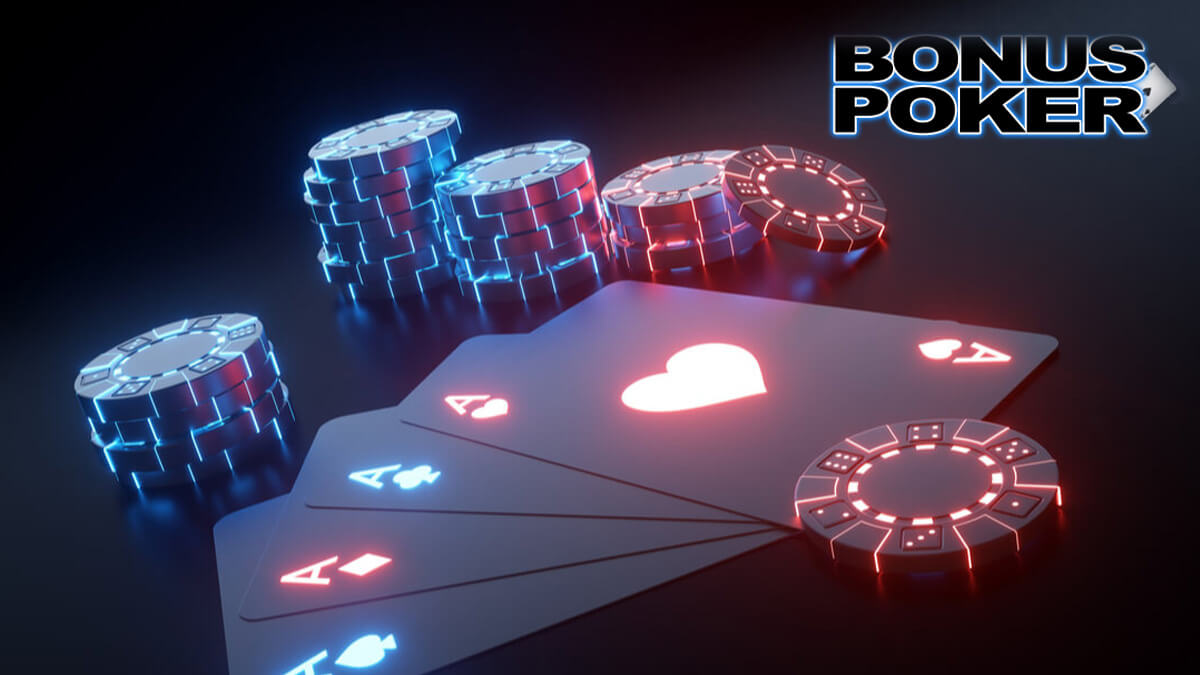What is Bonus Poker? And more importantly, how is it different from and similar to games like Double Bonus Poker, Double Double Bonus Poker, and Triple Bonus Poker?
The first thing to understand is the basics of video poker. Once you’ve got that under your belt, understanding Bonus Poker and its variations is just a matter of understanding the differences in the pay tables and how they affect the game.
Start by Learning to Play Jacks or Better Video Poker
Bonus Poker is a video poker game that’s based on Jacks or Better. To understand Bonus Poker, you must start by understanding Jacks or Better.
It’s a simple enough game, and you can learn how to play in minutes. You can even learn to play in a couple of hours, especially if you have some experience with card games.
To start a game of Jacks or Better or Bonus Poker, you input money into the machine, which converts that money into credits based on the denomination of the game. For example, if you’re playing a quarter machine and input $100, you’ll have 400 credits. Each of those credits is worth a quarter.
You choose how many credits to risk on each hand, between one and five. You should always choose five coins, though, because the jackpot is bigger when you’ve made the max bet.
You get your hand by pressing the deal button, and the computer gives you five cards. You get to decide which cards you want to keep by touching the screen on each card. You can also use a hold button that’s located under each card.
These buttons toggle the hold off and on, and the decision to hold the card is displayed on the screen. You can discard and replace zero to five cards.
Once you’ve decided which cards you’re going to keep, you press the deal button again to get replacement cards for the cards you’ve discarded. You get paid off based on the poker hand you wind up with and how they’re ranked in the pay table for the game.
The most basic pay table is for Jacks or Better, and Bonus Poker is just a variation of that.
Jacks or Better Pay Tables vs. Bonus Poker Pay Tables
Here’s a standard Jacks or Better pay table:
- Royal flush 800 for 1
- Straight flush 50 for 1
- Four of a kind 25 for 1
- Full house 9 for 1
- Flush 6 for 1
- Straight 4 for 1
- Three of a kind 3 for 1
- Two pairs 2 for 1
- A pair of jacks or higher 1 for 1
With that pay table combined with perfect strategy and a max bet, the payback percentage for Jacks or Better is 99.54%.
Contrast that Jacks or Better pay table with the pay table for Bonus Poker below:
- Royal flush 800 for 1
- Straight flush 50 for 1
- Four aces 80 for 1
- Four of a kind (2s, 3s, or 4s) 40 for 1
- Four of a kind (any other) 25 for 1
- Full house 8 for 1
- Flush 5 for 1
- Straight 4 for 1
- Three of a kind 3 for 1
- Two pairs 2 for 1
- Pair of jacks or better 1 for 1
The only real difference between these two games is based on the payouts for the four of a kind hands. In Bonus Poker, you get a “bonus” based on the ranking of the cards that make up your four of a kind.
And counterintuitively, that bonus isn’t necessarily based on how high the cards rank. Yes, the best payout is for four aces, which is the highest card. But the next best payout for a four of a kind is for the lowest ranked four of a kinds—twos, threes, or fours.
All the other four of a kinds, from fives all the way through kings, pay the worst for a four of a kind hand. Even then, the four of a kind pays the same as it does in Jacks or Better—25 for 1.
You’re basically getting a “bonus” payout for a four of a kind of four or below. That’s where the name comes from.
The other wrinkle that you’ll notice in the pay table is that a full house pays 8 for 1, and a flush pays 5 for 1. It’s not unusual to find Jacks or Better pay tables with those payouts, too. Those are the hands the casino adjusts to increase their house edge.
What Is “Double” Bonus Poker Then?
You’re going to love the difference in the pay table for Double Bonus Poker. It can be summed up simply, too.
They’ve just doubled the size of the payouts for the various four of a kind hands. All the other payouts are the same, except for the flush, which has been reduced to 7 for 1.
So, the pay table is the same except for the following changed values:
- Four aces 160 for 1
- Four of a kind (2s, 3s, or 4s) 80 for 1
- Four of a kind (any other) 50 for 1
- Flush 7 for 1
This has a big effect on the payback percentage for the game, though. If you play this variation with perfect strategy, you actually have an edge over the casino. The payback percentage is 100.17%, which means you have a tiny edge over the casino—0.17%.
What About Double Double Bonus Poker?
I’ve seen Double Double Bonus Poker called the most popular video poker game on the floor. Why is it so popular? The main reason is that the big payoffs get even when the game accounts for a kicker with a four of a kind.
So, the payout for four aces is 400 for 1 in this variation if you have a two, three, or four as your kicker. Otherwise, the payout is 160 for 1.
The payout for a four of a kind made up of twos, threes, or fours is also 160 for 1, if you have a kicker that’s four or lower. Otherwise, the payout is 80 for 1.
The payout for any other four of a kind is 50 for 1 regardless of the kicker. The payouts for the full house and flush are still important to the payback percentage for the game. The most common “best” pay table variation for Double Double Poker is a 9/6 game, one that pays off at 9 for 1 for a full house and 6 for 1 on a flush.
The payback percentage for that game is 98.98%. For practical purposes for most recreational gamblers, that’s the best video poker pay table that’a also easy to find in a casino.
And the strategy for Double Double Bonus Poker isn’t especially hard to learn either.
What Is Triple Bonus Poker?
You might be way ahead of me here. You might have already realized the Triple Bonus Poker is just Bonus Poker with the payouts for the four of a kind hands tripled instead of doubled.
Four aces now pays off at 240 for 1 instead of 80 for 1. A four of a kind made up of 2s, 3s, or 4s, pays off at 120 for 1 instead of 40 for 1. All other four of a kind hands pay off at 75 for 1.
They’ve reduced the payoff for two pairs to even money instead of 2 for 1 to pay for these bonuses. The payouts for the full house and flush vary, too, but sometimes they go up, too.
The change from 2 for 1 to even money on a two pair gives the machine a lot of flexibility in handling the other payouts. You get two pairs so much more often than hands like a full house or a flush that it’s easy to pay more on those hands and maintain a reasonable payback percentage that’s attractive to a player but still makes plenty of money for the casino.
There Are a Seemingly Endless Variety of Bonus Poker Games
You’ll also find games like Triple Double Bonus and more. These games are all just variations in the size of the pay tables, though. If you can play one of these games, you can play any of them.
Learning the appropriate strategy for each variation is the trick. I recommend Bob Dancer’s books on each game. Those are the most intuitive guides I’ve read to learning the strategies for these games.
That’s far from the only source, though. You can also buy video poker training software that will generate an appropriate strategy for you and even teach you how to play according to that strategy.
Conclusion
How do you play Bonus Poker? More or less the same way you play Jacks or Better, only you do have to make allowances in your strategy based on the different payouts for four of a kind.
This is true of all the other Bonus Poker variations you’ll encounter like Triple Bonus Poker and Double Double Bonus Poker.
The game you’ll encounter the most often, though, is Double Double Bonus Poker. If I were going to get good at any video poker variation, that would be the one I’d choose.
Michael Stevens
Michael Stevens has been researching and writing topics involving the gambling industry for well over a decade now and is considered an expert on all things casino and sports betting. Michael has been writing for GamblingSites.org since early 2016. …



